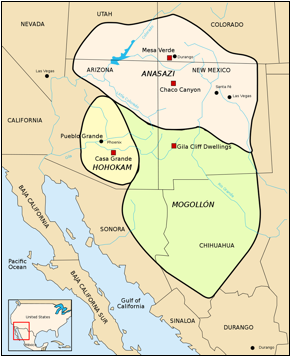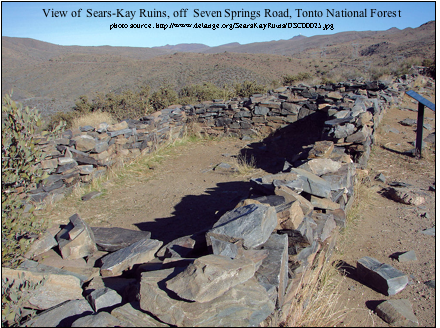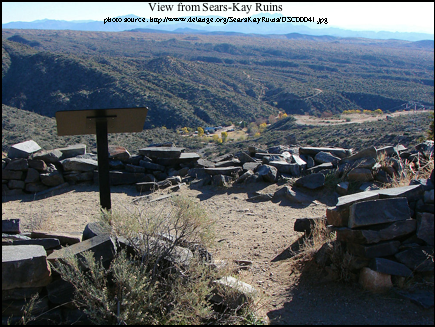MARCH 3, 2011
Archaeology in the Northern Periphery
The Desert Foothills: In Danger Of Being “All Used Up?”
The Desert Foothills has seen a continuing population expansion since the 1870s. The Western Apache and Yavapai Indians used the natural resources of the area to add to their food supply. The first United States citizens to traverse these hills were miners seeking mineral deposits they thought certainly existed just under the surface of mother earth. After the miners and army displaced the Indians the land was ready for cattle ranchers and farmers. The number of inhabitants in Cave Creek grew slowly until the end of World War II when the population of the entire Salt River Valley exploded.
farmers. The number of inhabitants in Cave Creek grew slowly until the end of World War II when the population of the entire Salt River Valley exploded.
Prehistoric population expansion in the Foothills was similar to what our culture has attained since the mid-1800s. Archaeologists have documented the presence of people in our area since at least 1000 BC. These Archaic people followed seasonal routes along waterways harvesting the plants and animals in one place and then moving on.
The date when man first arrived in the Americas is not precisely known. Current evidence indicates that he arrived about 14,000 BP (before present) or earlier. The ancestors of the American Indians migrated from northeast Asia across the land bridge that connected Siberia and Alaska. These people did not enter North America in huge groups but rather in small bands. The large animals were the source of much of the food for these people and they more than likely pursued their nourishment throughout the landmass of both continents.
Archaeologists named these hunters and gatherers the Paleo-Indians. The first concrete evidence of these people in North America at this early date was found at Clovis, New Mexico, when in 1927 a projectile point was found imbedded in the bones of a mammoth. This animal’s date of death was about 11,800 BC. The discovery of this point established man’s presence in the area. It also proved he had the tools and the skills to kill the large animals.

At the end of the Pleistocene age, the climate became much warmer. With the hotter temperatures the mega fauna became extinct. Man was forced to find a different source of nourishment.
The Archaic people lived throughout the American Southwest. By 7000 BC they were wanderers, following the seasonal development of native food crops. About 3000 years ago these people discovered that by placing rocks and other moisture conserving materials around native plants they produced much better crops.

These primitive gardening techniques led to the development of a complete agricultural system. With the introduction of a better source of food these wanderers decided to build permanent homes.
They constructed many of the ruins we visit today.
Cave Creek and most of the Desert Foothills are located in the part of south central Arizona traditionally recognized as the Hohokam Northern Periphery. The periphery extends north from the Phoenix Basin covering an area between the Agua Fria River on the west and the Verde River on the east. How far north this culture existed is still to be determined.
The Archaic period in the Hohokam Northern Periphery essentially spanned most of the middle Holocene climate epoch (7000 BC - 1200 BC). Archaic time frame sites have been found throughout the Desert Foothills. The petroglyphs located near Cave Creek and other major drainages have elements predating the arrival of the Hohokam. Until recently, few Archaic sites had been thoroughly investigated.
In 1974 William G. Holliday conducted an extensive archaeological survey of the Cave Creek drainage. This survey ran from south to north. The Cave Buttes sites, including Fort Mountain, marked the southern boundary. Holiday’s work ran north to the 6L Ranch, a site located on patented land surrounded by the Tonto National Forest. He was the first person to record and receive site numbers on the Spur Cross Ranch property. His work was published under the title, Archaeological Investigations in the Cave Creek Drainage. Tonto National Forest, Arizona. This publication was Archaeological Report No. 1, USDA Forest Service Southwestern Region, Albuquerque. This report has been used as a reference by most subsequent investigators.
Archaeological work conducted in the 1980s established patterns for the location of sites along the Cave Creek Drainage. Large to medium-sized agricultural fields are associated with canal irrigation, field houses, masonry structures and artifact assemblages. These traits indicate intensive farming.
When Carefree Highway was widened, a pithouse containing many pots, spindle whorls and cotton seed was excavated. The amount of cotton seed present indicated that this crop was grown to be exported.
The golden age of the Hohokam in the Foothills seems to be the Sedentary Period, the Sacaton Phase. The approximate dates for this time frame are 900 to 1150 AD. After these dates most of the larger ruins in the Cave Creek area had been deserted. There is speculation that part of the population moved east toward the Verde River. Lack of rain, depletion of resources, and overpopulation are reasons given for the exodus of the prehistoric population.
At the present date the Desert Foothills is in a period of drought. The water table is dropping and the population is growing at a rapid rate. Central Arizona is a desert environment. Our culture has learned to expand the available sources of water, but water is a finite resource. Will we be able to continue to use this resource at our present rate or will we repeat the pattern of the Hohokam? The word Hohokam is derived from the Pima language and is interpreted to mean “All used up.”


